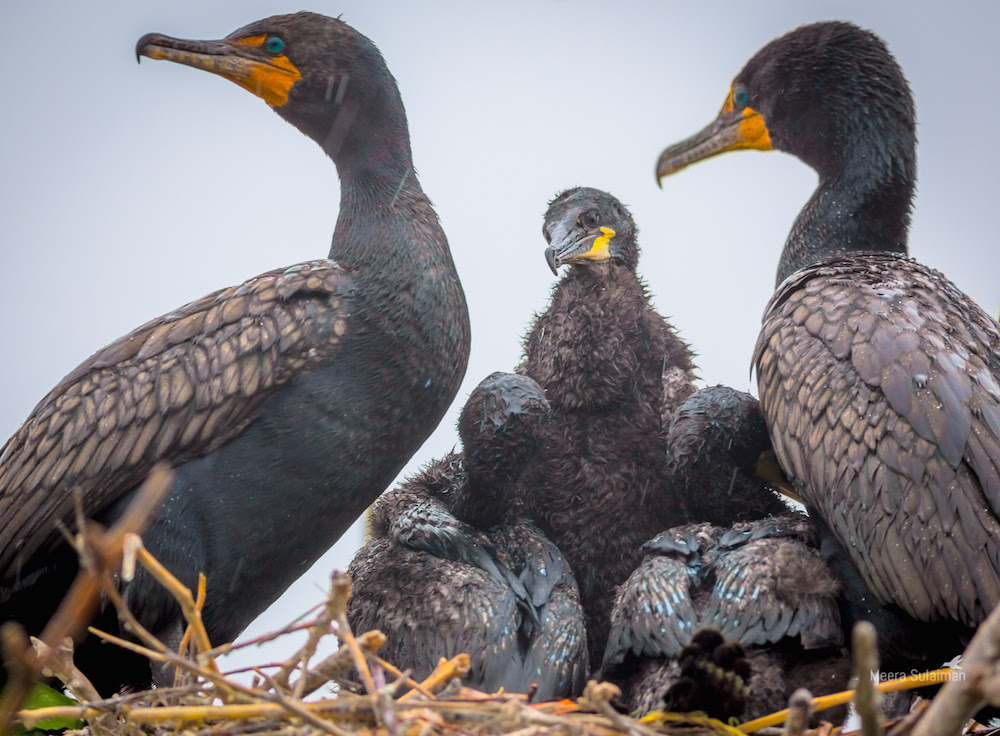Wednesday January 3: the province’s deadline for comment on plan to kill cormorants

Double-crested cormorants on the nest. It takes both male and female cormorants to raise the young – shooting one would result in the chicks dying.
AWARE News Network
Edward Kroc, assistant professor of Measurement, Evaluation, and Research Methodology at the University of British Columbia has studied the Ontario government’s proposed hunt of the Double-Crested Cormorant, which will allow hunters to kill 50 birds a day from March 31 to December 15.
He finds it scientifically baseless and environmentally naïve. He points out that it is not only absurd, but also cruel. The exceptionally long open season covers the entire time these migratory birds are in the Great Lakes, including when they are on the nest.
The deadline for public comment is January 3, 2019. To comment, click on the government posting on the Environmental Registry, scroll down to the bottom of the page and click on the button that says ‘submit a comment.’
In its posting, the government recognizes that the Great Lakes cormorant population has stabilized or declined. However, it says, there are “concerns” that cormorants are detrimental to fish populations and vegetation.
On the first point, Kroc notes that that fish most attractive to human fishermen (Lake Trout and Salmon) comprise less than 2% of cormorant diets, and that cormorants consume about 0.5% of critical prey fish, an insignificant number especially when compared against the 13% taken by sport fishermen.
As for cormorant impact on vegetation, Kroc argues that localized non-lethal approaches should be considered first. Kroc states that the plan also ignores the interests of a wide variety of citizens who interact with wildlife without killing it. Kroc notes that birding alone is nearly 4 times more popular than hunting in Ontario, even more so among those aged 55+. On average, Ontario birders spend 139 days per year engaging in birding activities. Ontario hunters spend 44 days per year (on average) engaging in hunting activities (FPTGC 2014).
Full text of Kroc’s evaluation
The Ontario Federation of Anglers and Hunters has driven the campaign against cormorants, making control of “cormorant overabundance” one of its election issues. This is the OFAH submission
Others who have come out against the government’s proposal include:
– Bird Studies Canada expresses deep concern, arguing that the proposed changes pose significant harm to a native Ontario wildlife species, have the potential to negatively impact other wildlife species and habitats, and also lack scientific rationale or justification.
The organization states: “The proposed hunt is inconsistent with every tenet of wildlife management and hunting ethic, including failure to protect wildlife during the breeding season and permission to allow game meats to spoil. This proposed divergence from norms highlights the fact that this is not sport hunting by any standard definition, but is rather a broad-scale and largely unregulated cull.”
Full text of the BSC submission
– Gail Fraser, associate professor, Faculty of Environmental Studies, York University, an expert in colonial nesting waterbirds. She notes that the proposed hunt places other aquatic waterbirds species at risk, particularly ones that nest with cormorants (herons, egrets and gulls and terns). It is also likely to negatively impact bald eagles, that prey upon cormorants.
Fraser states: “Unlike ducks and mergansers, cormorants have altricial young whereboth members of a pair are required for nest success. The killing of either a male or a female during the breeding season will result in their chicks starving to death even if the other parent is present.”
Full text of Fraser’s submission
– Ontario Nature deplores the plan for an “unfettered killing of a wildlife species that some people simply don’t like. Indeed, the government’s response is lacking in any scientific justification or evidence. There is no information about the current population size, no population management target, no rationale for the incredibly high daily bag limit and no plan in place to monitor and assess impacts.”
Link to Ontario Nature letter to Natural Resources Minister John Yakabuski









Leave a Reply